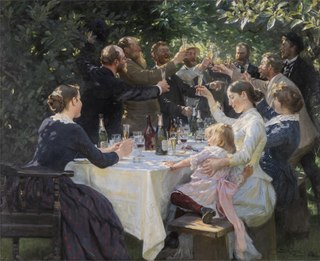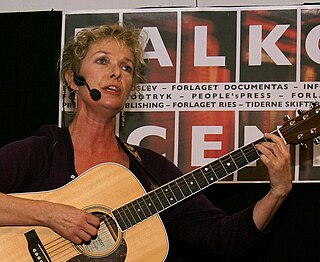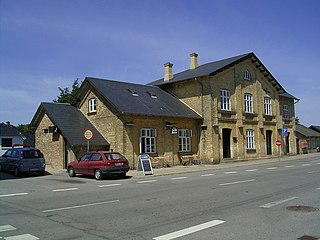
Impressionism was a 19th-century art movement characterized by relatively small, thin, yet visible brush strokes, open composition, emphasis on accurate depiction of light in its changing qualities, ordinary subject matter, unusual visual angles, and inclusion of movement as a crucial element of human perception and experience. Impressionism originated with a group of Paris-based artists whose independent exhibitions brought them to prominence during the 1870s and 1880s.

Naja Marie Aidt is a Danish-language poet and writer.

Herman Joachim Bang was a Danish journalist and author, one of the men of the Modern Breakthrough.

Laurits Andersen Ring was one of the foremost Danish painters of the turn of the 20th century, who pioneered both symbolism and social realism in Denmark. Considered one of the masterpieces of Danish culture, his painting Summer Day by Roskilde Fjord was included in the 2006 Danish Culture Canon.

Lorenz Peter Elfred Freuchen was a Danish explorer, author, journalist and anthropologist. He is notable for his role in Arctic exploration, namely the Thule Expeditions.
Katinka is a feminine given name possibly originating in Hungary. It is the pet form of Katerina or Ekaterina, meaning "pure" and cognate to the English name Catherine. It may also refer to:

Dorrit Willumsen is a Danish writer. She made her literary debut in 1965 with the short story collection Knagen.

Katinka is a 1988 Danish-Swedish drama film directed by Max von Sydow and starring Tammi Øst. Based on Herman Bang's novel Ved Vejen (1886) which is included in the Danish Culture Canon, it was screened in the Un Certain Regard section at the 1988 Cannes Film Festival. At the 24th Guldbagge Awards it won the award for Best Film and Von Sydow won the award for Best Director.

The Skagen Painters were a group of Scandinavian artists who gathered in the village of Skagen, the northernmost part of Denmark, from the late 1870s until the turn of the century. Skagen was a summer destination whose scenic nature, local milieu and social community attracted northern artists to paint en plein air, emulating the French Impressionists—though members of the Skagen colony were also influenced by Realist movements such as the Barbizon school. They broke away from the rather rigid traditions of the Royal Danish Academy of Fine Arts and the Royal Swedish Academy of Arts, espousing the latest trends that they had learned in Paris. Among the group were Anna and Michael Ancher, Peder Severin Krøyer, Holger Drachmann, Karl Madsen, Laurits Tuxen, Marie Krøyer, Carl Locher, Viggo Johansen and Thorvald Niss from Denmark, Oscar Björck and Johan Krouthén from Sweden, and Christian Krohg and Eilif Peterssen from Norway. The group gathered together regularly at the Brøndums Hotel.

Tammi Øst is a Danish actress.

Karen Lydia Aabye was a Danish writer. In the late 1930s, she worked as a journalist in Paris and London before she gained popularity with a number of historical novels in which strong-willed women were her main characters. Her works also include travel books and a collection of essays.

Skørping railway station is a Danish railway station serving the railway town of Skørping in Himmerland south of Aalborg, Denmark.

Peder Severin Krøyer painted various portraits of his wife, Marie Krøyer née Triepcke, a fellow Danish artist who was said to be one of the most beautiful women in Copenhagen. Norwegian-born Peder had met and painted Marie in Copenhagen but fell in love with her when they met in Paris in 1889. After a honeymoon in northern Jutland and Italy, the couple settled in Skagen on the northern tip of Jutland in 1891, joining the group of artists that became known as the Skagen Painters.
Mary Jane Crafoord Muus was a Danish painter and illustrator. Most of her works portray people, either in portraits or walking about on streets or market places in foreign countries. She is remembered above all for her sensitive, realistic illustrations in a wide range of Danish books. One of Denmark's foremost 20th-century illustrators, she had a unique style of her own.

Agnes Kathinka Malling Henningsen was a Danish writer and an activist for sexual freedom. Her writings were centred on love and sex, as was her own life.

Kristín Jónsdóttir, also Kristín Jónsdóttir Stefánsson (1888–1959), was a pioneering female Icelandic painter. A member of the group of artists who associated with the painter Jón Stefánsson, she was inspired by the art of Paul Cézanne and by French Impressionism.

Marie Henriques was a Danish painter who created landscapes, figure paintings and portraits, initially in the Realist style but increasingly under the influence of Impressionism. She also painted watercolours of ancient architecture and sculpture. In 1916, she was a founding member of the Society of Women Artists .
Brigitte Käthe Kolerus (1941–2001) was an Austrian-born Danish actress who performed in films and on television but mainly on stage. After studying at the Odense Teater drama school, she appeared in the musical Man of La Mancha at Ungdommens Teater in 1967 and went on to play Desdemona in Shakespeare's Othello at Det Danske Teater in 1969. She made a name for herself in films by appearing in erotic scenes in Erik Frohn Nielsen's Ekko af et skud in 1970. Kolerus also served as director of Copenhagen's Teatret ved Sorte Hest from 1978 and staged plays and operas at a number of venues.
Vivian Yvonne Mitchell Greene-Gantzberg was an American educator and author with an expertise in 18th and 19th century Danish and German literature.

Hans Kaarsberg was a Danish medical doctor, writer and adventurer. In 1890, he went on a one-man expedition to Kalmykia in search of the last remains of the Kalmyk people. His account of the journey was published by Gyldendal in 1892. Among the Kalmyks of the Steppes on Horseback and by Troika: A Journey Made in 1890, an English-language translation of the book, was published by the Mongolian Society in 1996. In 2021. prompted by Kaarsberg Mysteriet, a five-episode DR podcast created by Klaus Rothstein. Kaarsberg attracted renewed attention for having inspired a young Karen Blixen's interest in travels, hunting and writing. Kaarsberg was the brother of surgeon Johannes Kaarsberg and author Ellen Reumert.


















